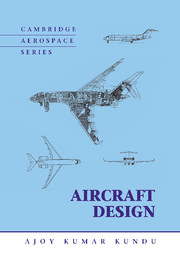Book contents
- Frontmatter
- Contents
- List of Symbols and Abbreviations
- Preface
- Road Map of the Book
- 1 Introduction
- 2 Methodology to Aircraft Design, Market Survey, and Airworthiness
- 3 Aerodynamic Considerations
- 4 Aircraft Classification, Statistics, and Choices for Configuration
- 5 Aircraft Load
- 6 Configuring Aircraft
- 7 Undercarriage
- 8 Aircraft Weight and Center of Gravity Estimation
- 9 Aircraft Drag
- 10 Aircraft Power Plant and Integration
- 11 Aircraft Sizing, Engine Matching, and Variant Derivative
- 12 Stability Considerations Affecting Aircraft Configuration
- 13 Aircraft Performance
- 14 Computational Fluid Dynamics
- 15 Miscellaneous Design Considerations
- 16 Aircraft Cost Considerations
- 17 Aircraft Manufacturing Considerations
- Appendix A Conversion
- Appendix B International Standard Atmosphere
- Appendix C Aerofoils
- Appendix D Case Studies
- Appendix E Tire Data
- References
- Index
9 - Aircraft Drag
Published online by Cambridge University Press: 05 June 2012
- Frontmatter
- Contents
- List of Symbols and Abbreviations
- Preface
- Road Map of the Book
- 1 Introduction
- 2 Methodology to Aircraft Design, Market Survey, and Airworthiness
- 3 Aerodynamic Considerations
- 4 Aircraft Classification, Statistics, and Choices for Configuration
- 5 Aircraft Load
- 6 Configuring Aircraft
- 7 Undercarriage
- 8 Aircraft Weight and Center of Gravity Estimation
- 9 Aircraft Drag
- 10 Aircraft Power Plant and Integration
- 11 Aircraft Sizing, Engine Matching, and Variant Derivative
- 12 Stability Considerations Affecting Aircraft Configuration
- 13 Aircraft Performance
- 14 Computational Fluid Dynamics
- 15 Miscellaneous Design Considerations
- 16 Aircraft Cost Considerations
- 17 Aircraft Manufacturing Considerations
- Appendix A Conversion
- Appendix B International Standard Atmosphere
- Appendix C Aerofoils
- Appendix D Case Studies
- Appendix E Tire Data
- References
- Index
Summary
Overview
An important task in aircraft design is to make the best possible estimation of all the different types of drag associated with aircraft aerodynamics. Commercial aircraft design is sensitive to the DOC, which is aircraft-drag–dependent. Just one count of drag (i.e., CD = 0.0001) could account for several million U.S. dollars in operating cost over the lifespan of a small fleet of midsized aircraft. This will become increasingly important with the increasing trend in fuel costs. Accurate estimation of the different types of drag remains a central theme. (Equally important are other ways to reduce DOC as described in Section 2.1; these are discussed in Chapter 17.)
For a century, a massive effort has been made to understand and estimate drag, and the work is still continuing. Possibly some of the best work on aircraft drag in English is compiled by NACA/NASA, RAE, AGARD, ESDU, DATCOM, Royal Aeronautical Society (RAeS), AIAA, and others. These publications indicate that the drag phenomena are still not fully understood and that the way to estimate aircraft drag is by using semi-empirical relations. CFD (see Chapter 14) is gaining ground but it is still some way from supplanting the proven semi-empirical relations. In the case of work on excrescence drag, efforts are lagging.
The 2D-surface skin friction drag, elliptically loaded induced drag, and wave drag can be accurately estimated – together, they comprise most of the total aircraft drag.
- Type
- Chapter
- Information
- Aircraft Design , pp. 258 - 313Publisher: Cambridge University PressPrint publication year: 2010



